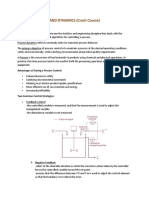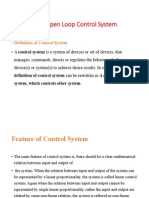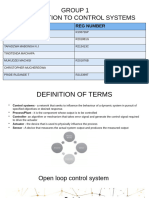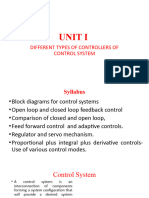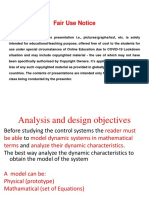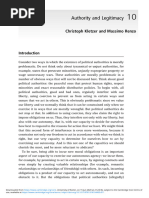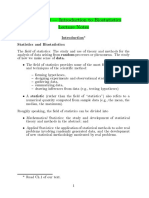0 ratings0% found this document useful (0 votes)
16 viewsLecture One - Control Systems and PID
Uploaded by
Maryjane MJCopyright
© © All Rights Reserved
Available Formats
Download as PDF, TXT or read online on Scribd
0 ratings0% found this document useful (0 votes)
16 viewsLecture One - Control Systems and PID
Uploaded by
Maryjane MJCopyright
© © All Rights Reserved
Available Formats
Download as PDF, TXT or read online on Scribd
You are on page 1/ 21
RDA 211: ADVANCED CONTROL
THEORY FOR MOBILE ROBOTS
Lecture 01:
CONTROL SYSTEMS AND PID CONTROLLERS (REVISED)
DEFINITION
• A control system is a system of devices or set of devices, that manages,
commands, directs or regulates the behavior of other devices or systems to
achieve desired results. In other words, the definition of a control system can be
simplified as a system, which controls other systems.
• . A bathroom toilet tank, a refrigerator, an air conditioner, a geezer, an automatic
iron, an automobile all are control system.
• We find control systems in the quality control of products, weapons system,
transportation systems, power system, space technology, robotics and many
more.
• The principles of control theory are applicable to both engineering and non-
engineering field.
TYPES OF CONTROL SYSTEMS
• There are various types of control systems but all of them are created
to control outputs.
• Hence, there are two main types of control system
• Open loop control system
• Closed loop control system
OPEN LOOP CONTROL SYSTEMS
• A control system in which the control action is totally independent of output of the system then it is called
open loop control system.
• A manual control system is also an open loop control system.
• The figure below shows a control system block diagram of an open loop control system in which process
output is totally independent of the controller action.
PRACTICAL EXAMPLES OF OPEN LOOP
CONTROL SYSTEMS
• Electric Hand Drier – Hot air (output) comes out as long as you keep your hand under the
machine, irrespective of how much your hand is dried.
• Automatic Washing Machine – This machine runs according to the pre-set time irrespective of
washing is completed or not.
• Bread Toaster – This machine runs as per adjusted time irrespective of toasting is completed or
not.
• Automatic Tea/Coffee Maker – These machines also function for pre adjusted time only.
• Timer Based Clothes Drier – This machine dries wet clothes for pre-adjusted time, it does not
matter how much the clothes are dried.
ADVANTAGES OF OPEN LOOP CONTROL
SYSTEMS
• Simple in construction and design.
• Economical.
• Easy to maintain.
• Generally stable.
• Convenient to use as output is difficult to measure
DISADVANTAGES OF OPEN LOOP CONTROL
SYSTEMS
• They are inaccurate.
• They are unreliable.
• Any change in output cannot be corrected automatically
CLOSED LOOP CONTROL
• Control system in which the output has an effect on the input quantity in such a manner that the input
quantity will adjust itself based on the output generated is called closed loop control system.
• Open loop control system can be converted in to closed loop control system by providing a feedback.
• This feedback automatically makes the suitable changes in the output due to external disturbance.
• In this way closed loop control system is called automatic control system.
PRACTICAL EXAMPLES OF CLOSED LOOP
CONTROL SYSTEM
• Automatic Electric Iron – Heating
elements are controlled by output
temperature of the iron.
• Servo Voltage Stabilizer – Voltage
controller operates depending upon
output voltage of the system.
• Water Level Controller – Input water is
controlled by water level of the
reservoir.
• Missile Launched and Auto Tracked by
Radar – The direction of missile is
controlled by comparing the target and
position of the missile.
ADVANTAGES OF CLOSED LOOP CONTROL
SYSTEMS
• Closed loop control systems are more accurate even in the presence
of non-linearity.
• Highly accurate as any error arising is corrected due to presence of
feedback signal.
• Bandwidth range is large.
• Facilitates automation.
• The sensitivity of system may be made small to make system more
stable.
• This system is less affected by noise.
DISADVANTAGES OF CLOSED LOOP CONTROL
SYSTEMS
• They are costlier.
• They are complicated to design.
• Required more maintenance.
• Feedback leads to oscillatory response.
• Overall gain is reduced due to presence of feedback.
• Stability is the major problem and more care is needed to design a
stable closed loop system.
FEEDBACK LOOP OF CONTROL SYSTEMS
• A feedback is a common and powerful tool when designing a control system.
• Feedback loop is the tool which take the system output into consideration and enables the system to adjust
its performance to meet a desired result of system.
• In any control system, the output is affected due to change in environmental condition or any kind of
disturbance.
• One signal is taken from the output and is fed back to the input. This signal is compared with a reference
input and the error signal is generated. This error signal is applied to controller and output is corrected.
EFFECTS OF FEEDBACK
• Error between system input and system output is reduced.
• System gain is reduced by a factor 1/(1±GH).
• Improvement in sensitivity.
• Stability may be affected.
• Improve the speed of response
PID CONTROLLERS
• A proportional-integral-derivative controller (PID controller) is a control loop
feedback mechanism (controller) widely used in industrial control systems.
• A PID controller calculates an error value as the difference between a measured
process variable and a desired setpoint.
• The controller attempts to minimize the error by adjusting the process through
use of a manipulated variable.
• The PID controller algorithm involves three separate constant parameters, and is
accordingly sometimes called three-term control: the proportional, the integral
and derivative values, denoted P, I, and D.
• Simply put, these values can be interpreted in terms of time: P depends on the
present error, I on the accumulation of past errors, and D is a prediction of future
errors, based on current rate of change.
PROPORTIONAL TERM
• The proportional term produces an output value that is proportional
to the current error value.
• The proportional response can be adjusted by multiplying the error
by a constant Kp, called the proportional gain constant
• The proportional term is given by:
• 𝑃𝑜𝑢𝑡 = 𝐾𝑝𝑒(𝑡)
• If the proportional gain is too high, the system can become unstable.
• A small gain results in a small output response to a large input error,
and a less responsive or less sensitive controller.
INTEGRAL TERM
• The contribution from the integral term is proportional to both the
magnitude of the error and the duration of the error.
• The integral in a PID controller is the sum of the instantaneous error
over time and gives the accumulated offset that should have been
corrected previously.
• The accumulated error is then multiplied by the integral gain 𝑲𝒊 and
added to the controller output.
• 𝐼𝑂𝑢𝑡 = 𝐾𝑖 ∫ 𝑒(𝜏)𝑑𝜏 𝑡 0
• Since the integral term responds to accumulated errors from the past,
it can cause the present value to overshoot the set-point value
DERIVATIVE TERM
• The derivative of the process error is calculated by determining the
slope of the error over time and multiplying this rate of change by the
derivative gain 𝐾d.
• The magnitude of the contribution of the derivative term to the
overall control action is termed the derivative gain, 𝐾d. The derivative
term is given by
• 𝐷𝑜𝑢𝑡 = 𝐾𝑑 𝑑/𝑑𝑡 𝑒(𝑡)
• Derivative action predicts system behavior and thus improves settling
time and stability of the system.
You might also like
- Form One Integrated Science End of Year Exam75% (4)Form One Integrated Science End of Year Exam10 pages
- CS2 B Chapters 4 and 5 - Markov Jump Processes - QuestionsNo ratings yetCS2 B Chapters 4 and 5 - Markov Jump Processes - Questions3 pages
- Unit I Introduction To Mechatronics R&a 2023No ratings yetUnit I Introduction To Mechatronics R&a 2023103 pages
- CPN Chapter1 Marlin 1.1-1.10 26-07-2022No ratings yetCPN Chapter1 Marlin 1.1-1.10 26-07-202249 pages
- 2-introduction to control system , ref books etc-15-07-2024No ratings yet2-introduction to control system , ref books etc-15-07-202425 pages
- Introducation To Linear Control SystemsNo ratings yetIntroducation To Linear Control Systems23 pages
- Chemical Engineering Department College of Engineering and Technology Adigrat UniversityNo ratings yetChemical Engineering Department College of Engineering and Technology Adigrat University33 pages
- Process Control & Automation: Sobukola, O.P. (PHD) /kajihausa, O.E. (MRS)No ratings yetProcess Control & Automation: Sobukola, O.P. (PHD) /kajihausa, O.E. (MRS)24 pages
- Automation 2 Topic 1: Design A Simple Process Control SystemNo ratings yetAutomation 2 Topic 1: Design A Simple Process Control System12 pages
- Control and Modelling of Bioprocesses: Slides Adapted From Dr. Katie ThirdNo ratings yetControl and Modelling of Bioprocesses: Slides Adapted From Dr. Katie Third54 pages
- 1-Analysis and Design Objectives and Open Loop and Closed Loop Control SystemNo ratings yet1-Analysis and Design Objectives and Open Loop and Closed Loop Control System33 pages
- 455_FST 506 Lecture Note-Mrs Kaji HausaNo ratings yet455_FST 506 Lecture Note-Mrs Kaji Hausa24 pages
- Lab1 Introduction to Analog Control Laboratory 18-12-2023No ratings yetLab1 Introduction to Analog Control Laboratory 18-12-202319 pages
- Self sensing concrete in smart structures 1st Edition Baoguo Han - Download the ebook today and own the complete content100% (2)Self sensing concrete in smart structures 1st Edition Baoguo Han - Download the ebook today and own the complete content65 pages
- Energy and Exergical Dissection of Gas Sweetening Using MDEA - Banat 2014No ratings yetEnergy and Exergical Dissection of Gas Sweetening Using MDEA - Banat 20147 pages
- Authority and Legitimacy: Christoph Kletzer and Massimo RenzoNo ratings yetAuthority and Legitimacy: Christoph Kletzer and Massimo Renzo17 pages
- Schedule For Summer Special Reappear (First Year Engineering)No ratings yetSchedule For Summer Special Reappear (First Year Engineering)6 pages
- Geomagnetic Disturbances Impacts on Power Systems: Risk Analysis and Mitigation Strategies 1st Edition Olga Sokolova - The ebook is ready for download to explore the complete content100% (2)Geomagnetic Disturbances Impacts on Power Systems: Risk Analysis and Mitigation Strategies 1st Edition Olga Sokolova - The ebook is ready for download to explore the complete content55 pages
- Kumasi Girls' Senior High School: Personal Records FormNo ratings yetKumasi Girls' Senior High School: Personal Records Form2 pages
- Saving The Earth Starts With You: Care For God'S CreationNo ratings yetSaving The Earth Starts With You: Care For God'S Creation13 pages
- International Journal of Solids and Structures: L. Wu, L. Noels, L. Adam, I. DoghriNo ratings yetInternational Journal of Solids and Structures: L. Wu, L. Noels, L. Adam, I. Doghri18 pages
- Foundation Drawings-2: 8 Thick Polymer Cement Mortar Waterproof LayerNo ratings yetFoundation Drawings-2: 8 Thick Polymer Cement Mortar Waterproof Layer1 page
- CS2 B Chapters 4 and 5 - Markov Jump Processes - QuestionsCS2 B Chapters 4 and 5 - Markov Jump Processes - Questions
- 2-introduction to control system , ref books etc-15-07-20242-introduction to control system , ref books etc-15-07-2024
- Chemical Engineering Department College of Engineering and Technology Adigrat UniversityChemical Engineering Department College of Engineering and Technology Adigrat University
- Process Control & Automation: Sobukola, O.P. (PHD) /kajihausa, O.E. (MRS)Process Control & Automation: Sobukola, O.P. (PHD) /kajihausa, O.E. (MRS)
- Automation 2 Topic 1: Design A Simple Process Control SystemAutomation 2 Topic 1: Design A Simple Process Control System
- Control and Modelling of Bioprocesses: Slides Adapted From Dr. Katie ThirdControl and Modelling of Bioprocesses: Slides Adapted From Dr. Katie Third
- 1-Analysis and Design Objectives and Open Loop and Closed Loop Control System1-Analysis and Design Objectives and Open Loop and Closed Loop Control System
- Lab1 Introduction to Analog Control Laboratory 18-12-2023Lab1 Introduction to Analog Control Laboratory 18-12-2023
- Control System: Fundamentals and ApplicationsFrom EverandControl System: Fundamentals and Applications
- Self sensing concrete in smart structures 1st Edition Baoguo Han - Download the ebook today and own the complete contentSelf sensing concrete in smart structures 1st Edition Baoguo Han - Download the ebook today and own the complete content
- Energy and Exergical Dissection of Gas Sweetening Using MDEA - Banat 2014Energy and Exergical Dissection of Gas Sweetening Using MDEA - Banat 2014
- Authority and Legitimacy: Christoph Kletzer and Massimo RenzoAuthority and Legitimacy: Christoph Kletzer and Massimo Renzo
- Schedule For Summer Special Reappear (First Year Engineering)Schedule For Summer Special Reappear (First Year Engineering)
- Geomagnetic Disturbances Impacts on Power Systems: Risk Analysis and Mitigation Strategies 1st Edition Olga Sokolova - The ebook is ready for download to explore the complete contentGeomagnetic Disturbances Impacts on Power Systems: Risk Analysis and Mitigation Strategies 1st Edition Olga Sokolova - The ebook is ready for download to explore the complete content
- Kumasi Girls' Senior High School: Personal Records FormKumasi Girls' Senior High School: Personal Records Form
- Saving The Earth Starts With You: Care For God'S CreationSaving The Earth Starts With You: Care For God'S Creation
- International Journal of Solids and Structures: L. Wu, L. Noels, L. Adam, I. DoghriInternational Journal of Solids and Structures: L. Wu, L. Noels, L. Adam, I. Doghri
- Foundation Drawings-2: 8 Thick Polymer Cement Mortar Waterproof LayerFoundation Drawings-2: 8 Thick Polymer Cement Mortar Waterproof Layer


